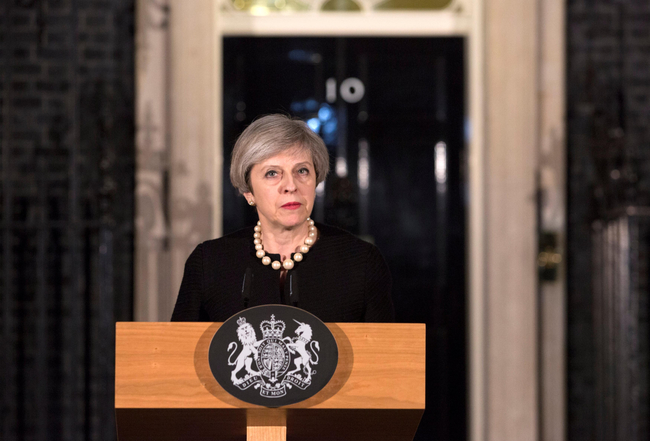On March 22, a terrorist attack occurred near the British Houses of Parliament, resulting in 4 people dead and almost 40 people injured. The attacker drove a car into a crowd of people walking on Westminster Bridge. Then, the black-clad man of Asian appearance, aged approximately 40 and armed with two knives, fatally wounded an unarmed policeman near the parliament building. Later on, the attacker was shot dead by other policemen.
Following the attack, the parliament building was surrounded by London counter-terrorism police, while medics and rescuers arrived on the scene. Prime Minister Theresa May was evacuated to her residence, and the remaining MPs were initially urged not to leave the building and then evacuated from it in an orderly manner. Westminster was on lockdown for five hours.
After an emergency meeting of the cabinet’s COBRA Civil Contingencies Committee, Prime Minister May labeled the attack a “sick and depraved” strike “at the heart of our capital city, where people of all nationalities, religions and cultures come together to celebrate the values of liberty and democracy.” She expressed confidence that such attempts to defeat British values were doomed to failure. By the way, the British prime minister also paid her respects on March 22 to the deceased policeman Keith Palmer and called him a hero.
Ms. May also said that the attacker was a British citizen from birth and was known to police and intelligence services. Making a statement in the House of Commons, she added that he had been investigated a few years ago in relation to concerns about violent extremism, but treated as “a peripheral figure.” The radical group calling itself the Islamic State declared on March 22 that the attacker was “a soldier of the Islamic State.”

REUTERS photo
Meanwhile, Scotland Yard reported that overnight, the police raided six dwellings and made eight arrests. “It is still our belief – which continues to be borne out by our investigation – that this attacker acted alone and was inspired by international terrorism,” said Mark Rowley, the national leader for counter terrorism policing and the acting deputy commissioner. He also asserted that at that stage, the police had no specific information about further threats to the public.
US President Donald Trump was among the first world leaders to offer support to the British leader. “Spoke to U.K. Prime Minister Theresa May today to offer condolences on the terrorist attack in London,” he tweeted.
“My thoughts are with all those affected by the horrific attack at the very heart of #London. #NATO stands united against terrorism,” tweeted NATO Secretary General Jens Stoltenberg.
Leaders of Western European countries, which were also affected by terrorist attacks lately, expressed solidarity with Britain after the attack in central London. In particular, French President Francois Hollande said that the French “know what the British people are suffering today.” A truck was driven into a crowd on the waterfront in Nice on July 14 past year during the celebration of Bastille Day, killing 84 people.
German Chancellor Angela Merkel said that her thoughts were with the Londoners and offered her condolences to the British. Let us recall that in December past year a similar attack took place in Berlin, when a truck crashed into the Christmas Fair crowd.
It should be noted that London’s previous encounter with terrorist attacks happened almost 12 years ago. In particular, four coordinated suicide bombings occurred in the British capital on July 7, 2005. Then, 52 people died and nearly 700 were wounded. Meanwhile, on July 21 of the same year, police managed to prevent terrorist attacks on the London Underground and on a bus.
Although the March 22 attack did not cause such great loss of life, it is symptomatic that it occurred exactly one year after the tragedy in Brussels, when a terrorist group claimed responsibility for the explosions in Brussels Airport and on the subway, which killed 35 civilians and 3 suicide bombers.
On the other hand, conclusions which the British press drew from the attack which occurred near the walls of Westminster are very interesting. “After Nice, Berlin and London, lone rampages look like pattern for future attacks,” Financial Times writes.
Meanwhile, another publication calls the attack near the parliament building another example of a new kind of terrorism, the “low-tech” one. According to this British publication, eradicating such “low-tech terrorism” is an extremely difficult task, since tracking down the attacker in advance is in most cases not possible.
“The lesson is plain: anyone with access to a motor vehicle can use it in a terror attack. And there is simply nothing very much to stop that. ... The intelligence services should receive generous funding in order to pursue as much suspicious activity as possible,” The Independent’s recipe goes.
The Guardian reported that the British intelligence services uncovered and foiled 12 terrorist plots in the past three years, but failed to prevent the 13th attack that happened on March 22. According to the publication, one of the first questions that will be raised is whether the attacker had been under surveillance.
“MI5 does not have the resources to maintain 24-hour surveillance on all possible suspects and has to make hard choices, that kind of intense watch is reserved only for those regarded as posing the highest risk,” explains The Guardian.
The simplest recipe of combating the attacks was probably the one proposed by The Sun, which believes that the government must consider a significant increase in armed patrols in the streets of British cities, despite the fact that this idea never seemed right before. “But the world has changed,” The Sun notes. “Guns will not deter attacks by those ready to die anyway. But they could certainly limit their impact and save many innocent lives, as they did yesterday [March 22. – Author].”








